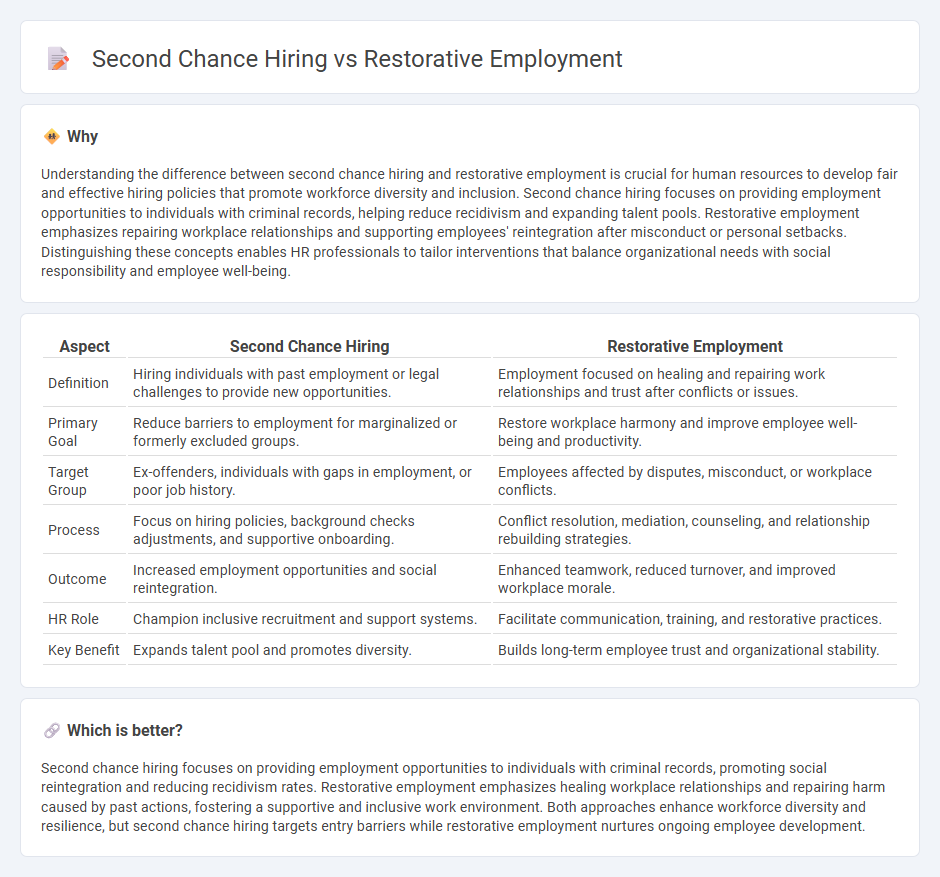
Second chance hiring focuses on offering employment opportunities to individuals with criminal records, aiming to reduce recidivism and promote societal reintegration. Restorative employment emphasizes repairing workplace relationships and fostering a supportive environment after conflicts or misconduct. Explore further to understand how these approaches transform Human Resources practices.
Why it is important
Understanding the difference between second chance hiring and restorative employment is crucial for human resources to develop fair and effective hiring policies that promote workforce diversity and inclusion. Second chance hiring focuses on providing employment opportunities to individuals with criminal records, helping reduce recidivism and expanding talent pools. Restorative employment emphasizes repairing workplace relationships and supporting employees' reintegration after misconduct or personal setbacks. Distinguishing these concepts enables HR professionals to tailor interventions that balance organizational needs with social responsibility and employee well-being.
Comparison Table
| Aspect | Second Chance Hiring | Restorative Employment |
|---|---|---|
| Definition | Hiring individuals with past employment or legal challenges to provide new opportunities. | Employment focused on healing and repairing work relationships and trust after conflicts or issues. |
| Primary Goal | Reduce barriers to employment for marginalized or formerly excluded groups. | Restore workplace harmony and improve employee well-being and productivity. |
| Target Group | Ex-offenders, individuals with gaps in employment, or poor job history. | Employees affected by disputes, misconduct, or workplace conflicts. |
| Process | Focus on hiring policies, background checks adjustments, and supportive onboarding. | Conflict resolution, mediation, counseling, and relationship rebuilding strategies. |
| Outcome | Increased employment opportunities and social reintegration. | Enhanced teamwork, reduced turnover, and improved workplace morale. |
| HR Role | Champion inclusive recruitment and support systems. | Facilitate communication, training, and restorative practices. |
| Key Benefit | Expands talent pool and promotes diversity. | Builds long-term employee trust and organizational stability. |
Which is better?
Second chance hiring focuses on providing employment opportunities to individuals with criminal records, promoting social reintegration and reducing recidivism rates. Restorative employment emphasizes healing workplace relationships and repairing harm caused by past actions, fostering a supportive and inclusive work environment. Both approaches enhance workforce diversity and resilience, but second chance hiring targets entry barriers while restorative employment nurtures ongoing employee development.
Connection
Second chance hiring and restorative employment intersect by focusing on reintegrating individuals with criminal records into the workforce, reducing recidivism through meaningful job opportunities. Both practices promote inclusive hiring policies that prioritize skills and potential over past mistakes, enhancing workforce diversity and social equity. Employers adopting these strategies benefit from improved employee loyalty, reduced turnover, and strengthened community relations.
Key Terms
Rehabilitation
Restorative employment centers on actively reintegrating formerly incarcerated individuals by providing tailored job opportunities that support skill development and community connection. Second chance hiring emphasizes offering employment to individuals with criminal records to reduce recidivism and promote economic stability. Explore how these approaches impact rehabilitation outcomes and workforce diversity.
Fair Chance Policies
Restorative employment centers on reintegrating formerly incarcerated individuals by addressing systemic barriers and promoting skill development, while second chance hiring broadly encourages employers to consider candidates with criminal records. Both approaches are integral to advancing Fair Chance Policies, which aim to reduce employment discrimination and foster economic inclusion for marginalized populations. Explore how these strategies reshape workforce diversity and equity by learning more about policy frameworks and successful implementation case studies.
Recidivism
Restorative employment emphasizes rehabilitating individuals with criminal records through supportive work environments that foster skills development and social reintegration, directly reducing recidivism rates. Second chance hiring involves employers giving job opportunities to ex-offenders, aiming to break cycles of re-offense by improving economic stability and social acceptance. Explore further to understand how these employment strategies impact recidivism and community safety outcomes.
Source and External Links
When Work Restores Dignity and Livelihoods - IIRP Graduate School - Restorative employment focuses on providing equitable job opportunities to formerly incarcerated individuals, restoring dignity, and fostering meaningful connections between these individuals and employers through restorative practices in workplace culture.
Restorative Justice Jobs, Employment in California | Indeed - Restorative employment roles often involve facilitating restorative justice practices, conflict resolution, and community-building in educational or social service contexts, requiring skills in counseling, education, or restorative justice.
Job Opportunities - nacrj - Growing community and restorative justice fields include opportunities in restorative employment focused on youth programs, case management, facilitation, and community conferencing, emphasizing healing and systemic justice.
 dowidth.com
dowidth.com